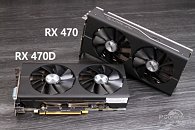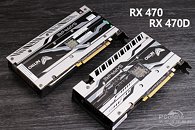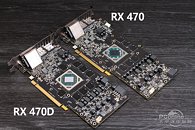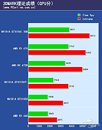- Joined
- Oct 9, 2007
- Messages
- 47,670 (7.43/day)
- Location
- Dublin, Ireland
| System Name | RBMK-1000 |
|---|---|
| Processor | AMD Ryzen 7 5700G |
| Motherboard | Gigabyte B550 AORUS Elite V2 |
| Cooling | DeepCool Gammax L240 V2 |
| Memory | 2x 16GB DDR4-3200 |
| Video Card(s) | Galax RTX 4070 Ti EX |
| Storage | Samsung 990 1TB |
| Display(s) | BenQ 1440p 60 Hz 27-inch |
| Case | Corsair Carbide 100R |
| Audio Device(s) | ASUS SupremeFX S1220A |
| Power Supply | Cooler Master MWE Gold 650W |
| Mouse | ASUS ROG Strix Impact |
| Keyboard | Gamdias Hermes E2 |
| Software | Windows 11 Pro |
It turns out that the new SKU based on the Polaris 10 "Ellesmere" silicon AMD is working on, to fill the gap between the Radeon RX 460 and RX 470, could be named the "Radeon RX 470D," after all. It is also being reported that AMD is planning to launch this SKU only in China, for now. It is further cut down from the RX 470, in featuring 1,792 stream processors, by enabling just 28 out of 36 GCN compute units physically present on the chip. The SKU further features 112 TMUs, 32 ROPs, and 4 GB of GDDR5 memory across a 256-bit wide memory interface.
AMD is clocking the RX 470D slightly higher than the conventional RX 470. Its core ticks at speeds of up to 1266 MHz (Boost clock), and its memory at 7.00 GHz (GDDR5-effective), compared to the 1206 MHz (Boost clock) and 6.60 GHz (GDDR5-effective) speeds of the RX 470. The RX 470D will be built to a cost, and it shows, on the Sapphire RX 470D NITRO. The PCB is shorter, and the cooler leaner. Chinese tech publication PCOnline got its hands on a sample, and tested it to be faster than the GeForce GTX 1050 Ti, yet slower than the RX 470. The card is expected to be priced about 14 percent less than the RX 470. Find more benchmark figures in the PCOnline review linked below.





View at TechPowerUp Main Site
AMD is clocking the RX 470D slightly higher than the conventional RX 470. Its core ticks at speeds of up to 1266 MHz (Boost clock), and its memory at 7.00 GHz (GDDR5-effective), compared to the 1206 MHz (Boost clock) and 6.60 GHz (GDDR5-effective) speeds of the RX 470. The RX 470D will be built to a cost, and it shows, on the Sapphire RX 470D NITRO. The PCB is shorter, and the cooler leaner. Chinese tech publication PCOnline got its hands on a sample, and tested it to be faster than the GeForce GTX 1050 Ti, yet slower than the RX 470. The card is expected to be priced about 14 percent less than the RX 470. Find more benchmark figures in the PCOnline review linked below.





View at TechPowerUp Main Site







